
Ozothamnus ferrugineus, commonly known as tree everlasting, is a member of the genus Ozothamnus, of the Asteraceae family – one of the largest families of flowering plants in Australia. Native to the Australian states of New South Wales, Victoria, South Australia, and Tasmania, it forms an erect shrub or small tree between 2 and 3 metres in height.

Polyarrhena is a genus of low, branching shrublets that is assigned to the daisy family. Its stems are alternately and densely set with entire or somewhat toothed leaves. Like in almost all Asteraceae, the individual flowers are 5-merous, small and clustered in typical heads, and which are surrounded by an involucre of in this case three whorls of bracts. In Polyarrhena, the centre of the head is taken by yellow disc florets, and is surrounded by one single whorl of white ligulate florets that have a pinkish-purple wash on the underside. These florets sit on a common base and are not individually subtended by a bract. The species occur in the Cape Floristic Region. Polyarrhena reflexa has long been cultivated as an ornamental and is often known under its synonym Aster reflexum.

Pimelea octophylla, commonly known as woolly riceflower or downy riceflower, is a species of flowering plant in the family Thymelaeaceae and is endemic to south-eastern continental Australia. It is an erect shrub with densely hairy young stems, narrowly elliptic leaves and heads of 22 to 45 densely hairy, cream-coloured to pale yellow flowers surrounded by 6 to 12 leaf-like involucral bracts.
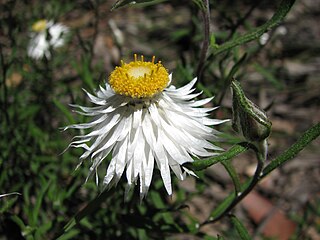
Helichrysum leucopsideum, commonly known as satin everlasting, is a flowering, perennial herb in the family Asteraceae. It is grows in all states of Australia except Queensland and the Northern Territory. It has white, terminal flower heads and narrow, woolly leaves.

Leucospermum bolusii is a shrub native to South Africa. It grows to 1.5 m in height, and has nearly hairless leaves with a single apical tooth. The leaves are oval shaped and range from 25–45 mm (0.98–1.77 in) in length. The flower heads are about 2 cm in diameter, slightly flattened globe shaped, are set on a stalk of about 1 cm and crowded with up to eight together at the tip of the branches. They each contain 50–100 small, sweetly scented creamy white flowers, that later turn light pink. Flowering takes place between September and December. It is called Gordon's Bay pincushion in English and witluisiesbos in Afrikaans.

Leucospermum secundifolium is a low, evergreen shrub that grows along the ground, the tip of the branches slightly rising, which has been assigned to the family Proteaceae. It has narrowly elliptic leaves with a distinct leafstalk, and few-flowered and very small heads of 1–1½ cm (0.4–0.6 in) across. It is called stalked pincushion in English. The sweetly scented flower heads may be found around early December. It is an endemic species that only grows in a small area of the Western Cape province of South-Africa.

Mimetes saxatilis or limestone pagoda is an evergreen, upright, rarely branching shrub of 1–2¼ m (3⅓–7¼ ft) high, assigned to the family Proteaceae. The approximately oval leaves are 3½–5 cm (1.4–2.0 in) long and 1½–3 cm (0.6–1.2 in) wide with a blunt, thickened, reddish tip or with three crowded teeth. It has cylinder-shaped inflorescences topped by a crest of green leaves, further consisting of heads with 12-22 individual bright yellow flowers, each in the axil of a flat, green leaf. It is an endemic species that is restricted to limestone outcrops in the Agulhas plains in the very south of the Western Cape province of South Africa. It is considered an endangered species. Flowering may occur between July and December, but is unreliable in its timing, dependent on sufficient moisture availability.
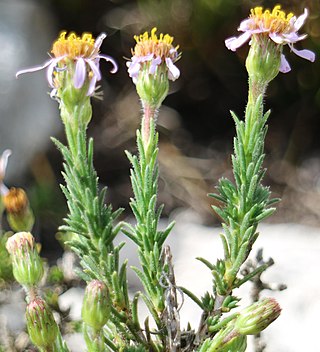
Felicia canaliculata is a grayish green shrublet in the family Asteraceae that grows up to 40 cm (16 in) in height. It has narrow, awl-shaped leaves, relatively large flower heads with approximately a dozen light purple to white ray florets encircling many yellow disc florets. It can only be found in the Western Cape province of South Africa.
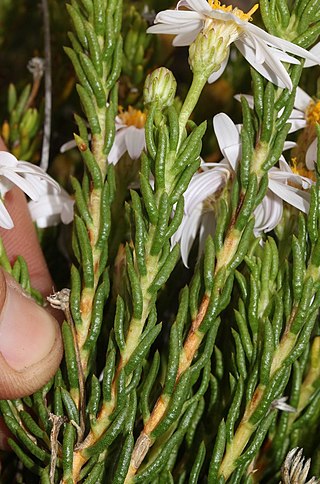
Felicia oleosa is an evergreen, richly branched dwarf shrub of up to 30 cm (12 in) high, that is assigned to the family Asteraceae. It has narrow, awl-shaped leaves, with translucent oil or resin dots, pointing upwards, crowded on the younger stems. The flower heads have about thirteen bright blue ray florets, encircling many yellow disc florets. This species grows in the mountains dividing the Karoo region of South Africa. It is sometimes called oily blue daisy in English.

Felicia nordenstamii is a flowering shrub in the family Asteraceae. It is found only in South Africa where it grows on limestone hills close to the sea on the southern coast. Felicia nordenstamii is a many-branched shrub growing up to 30 cm (1 ft) tall. The lower parts of the stems are covered in grayish brown bark and the upper stem has many crowded, upwardly angled, alternate leaves with long hairs on the lower surfaces. Large flower heads form at the tips of the branches, each about 41⁄2 cm across, with about thirty purplish blue ray florets surrounding many yellow disc florets.

Mairia coriacea is a perennial plant assigned to the family Asteraceae. It has broad, tough and leathery, evergreen leaves. These have a narrowed foot and an entire margin or a few shallow, irregular teeth. They grow in a rosette directly from the rootstock. The plant produces flower heads with one whorl of white to mauve ray florets around many yellow disc florets, with one or few on top of a dark reddish, woolly stalk. Flower heads appear after the overhead vegetation burnt down, often destroying the leaves in the process. It can be found in the southern mountains of South Africa's Western Cape province. It is called leather leaves in English.

Mairia burchellii is a tufted perennial plant of up to 15 cm (6 in) assigned to the family Asteraceae. It has narrow leaves of up to 5 mm (0.20 in) wide, with single main vein and an entire margin. Flower heads only occur after a fire has destroyed the standing vegetation, mostly in November or between February and June. The flower heads sit individually or with a few on the tip of a purplish stalk, with a few narrow bracts, and consist of a row of pinkish ray florets around many yellow disc florets. It can be found in the southwest of the Western Cape province of South Africa.

Mairia petiolata is a tufted, variably hairy, perennial plant of up to 15 cm (6 in) assigned to the family Asteraceae. Its leaves are in a ground rosette, and have a stalk of mostly 2–5 cm long and an inverted egg-shaped to elliptic, 61⁄2–9 cm (2.6–4.6 in) long and 2–3 cm wide leaf blade, with a toothed margin. It mostly has two flower heads at the tip of the branches of each erect, dark reddish brown scape. The flower heads have a bell- to cup-shaped involucre that consists of 20–24, purplish, overlapping bracts in 3–4 whorls. These protect 12–16 pink, ray florets, surrounding many yellow disc florets. This species was only seen flowering once, in December. It is known from one location in the Langeberg, Western Cape province of South Africa.

Mairia robusta is a tufted, white-woolly, perennial, herbaceous plant of up to 30 cm (1 ft) high, that is assigned to the family Asteraceae. It has large, robust, hard and leathery leaves, with a white woolly hairy, nontransparent underside, while the felty hairs on the top are lost with age. Only at a few occasions, flowers have been observed, in June, October and December, always after a fire. The flower heads sit individually at the tip of white-woolly scapes, with 14–16 purplish pink to white ray florets surrounding a yellow disc. M. robusta is an endemic species that is restricted to rocky mountain slopes in the Western Cape province of South Africa.

Mairia hirsuta is a tufted perennial, herbaceous plant of up to 40 cm high, that is assigned to the family Asteraceae. Most of its narrow to broad elliptic or inverted egg-shaped leaves are part of the basal rosette, have margin that is rolled under, with rounded or pointy teeth or with some peg-like extensions, lightly woolly on the upper surface and densely woolly on the underside, but always the green remains visible. Flower heads have been found from July to November, mostly after a fire or when the soil has been disturbed. The species can be found in the southern mountains of the Western Cape province of South Africa.

Cassinia thinicola commonly known as sand everlasting, is a species of flowering plant in the family Asteraceae and is endemic to coastal New South Wales. It is a compact shrub with hairy young stems, needle-shaped to slightly flattened leaves, and corymbs of up to 150 flower heads.
Olearia arckaringensis, commonly known as Arckaringensis daisy, is a species of flowering plant in the family Asteraceae and is endemic to a restricted area of northern South Australia. It is a small, compact, rounded shrub with woolly-hairy foliage, coarsely-toothed, elliptic leaves and lavender or white and yellow, daisy-like inflorescences.
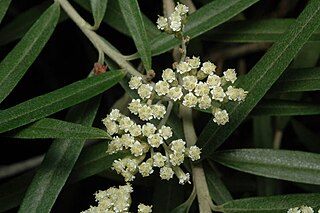
Ozothamnus stirlingii, commonly known as Ovens everlasting, is a flowering plant in the family Asteraceae and grows in New South Wales, Victoria and the Australian Capital Territory. It has globose-shaped white flower heads and sticky leaves.
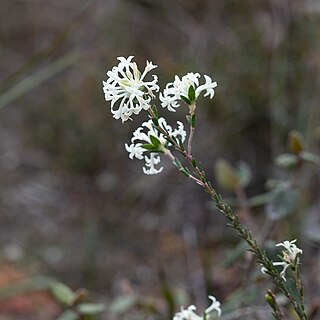
Pimelea phylicoides, commonly known as heath rice-flower, is a species of flowering plant in the family Thymelaeaceae and is endemic to southern continental Australia. It is an erect shrub with densely hairy young stems, narrowly egg-shaped to elliptic leaves, and heads of white flowers surrounded by 3 to 6 involucral bracts.

Argentipallium obtusifolium, commonly known as blunt everlasting, is a species of flowering plant in the family Asteraceae. It is a small, multi-stemmed perennial with white flowers, dark green leaves and is endemic to Australia.



















